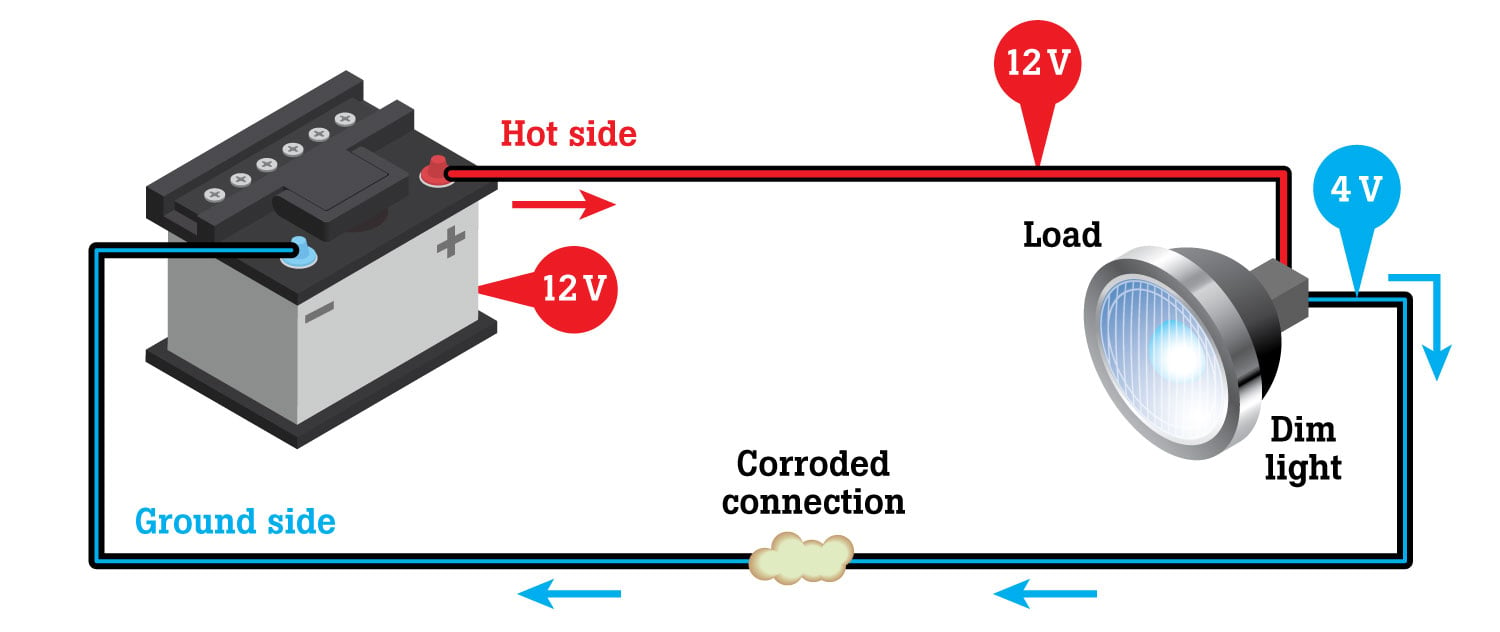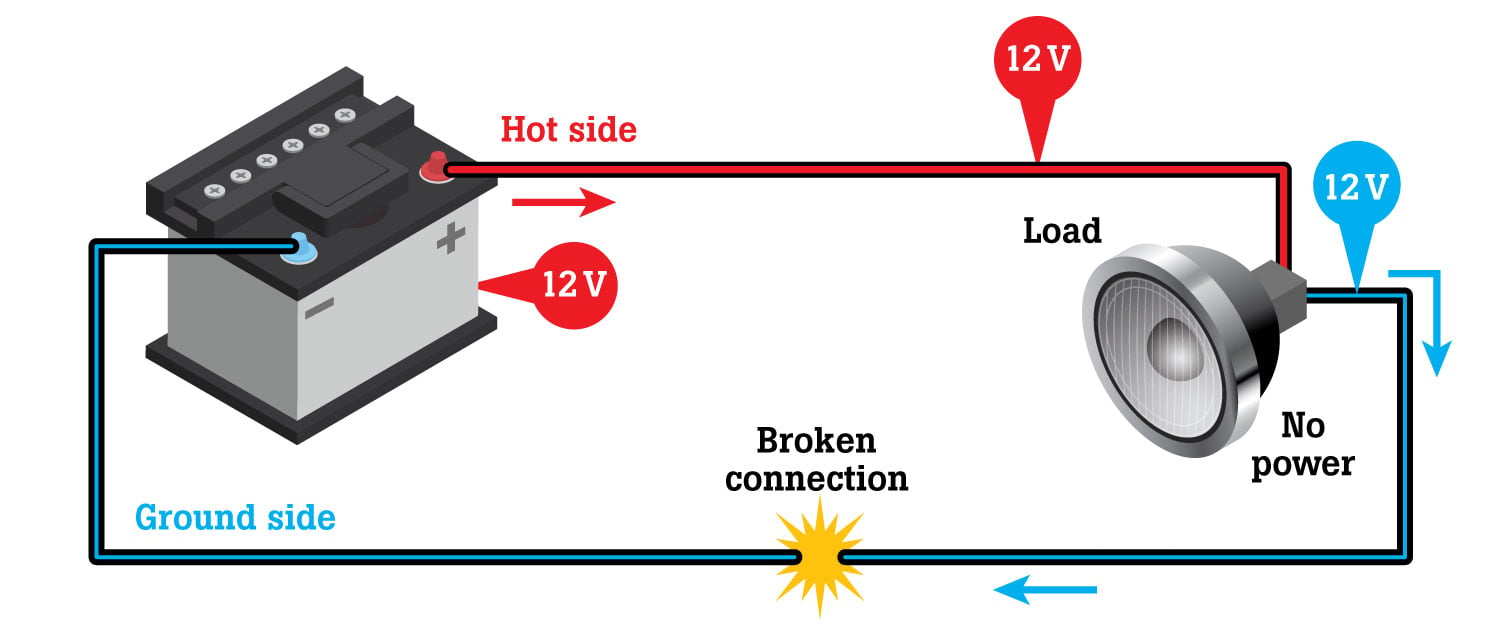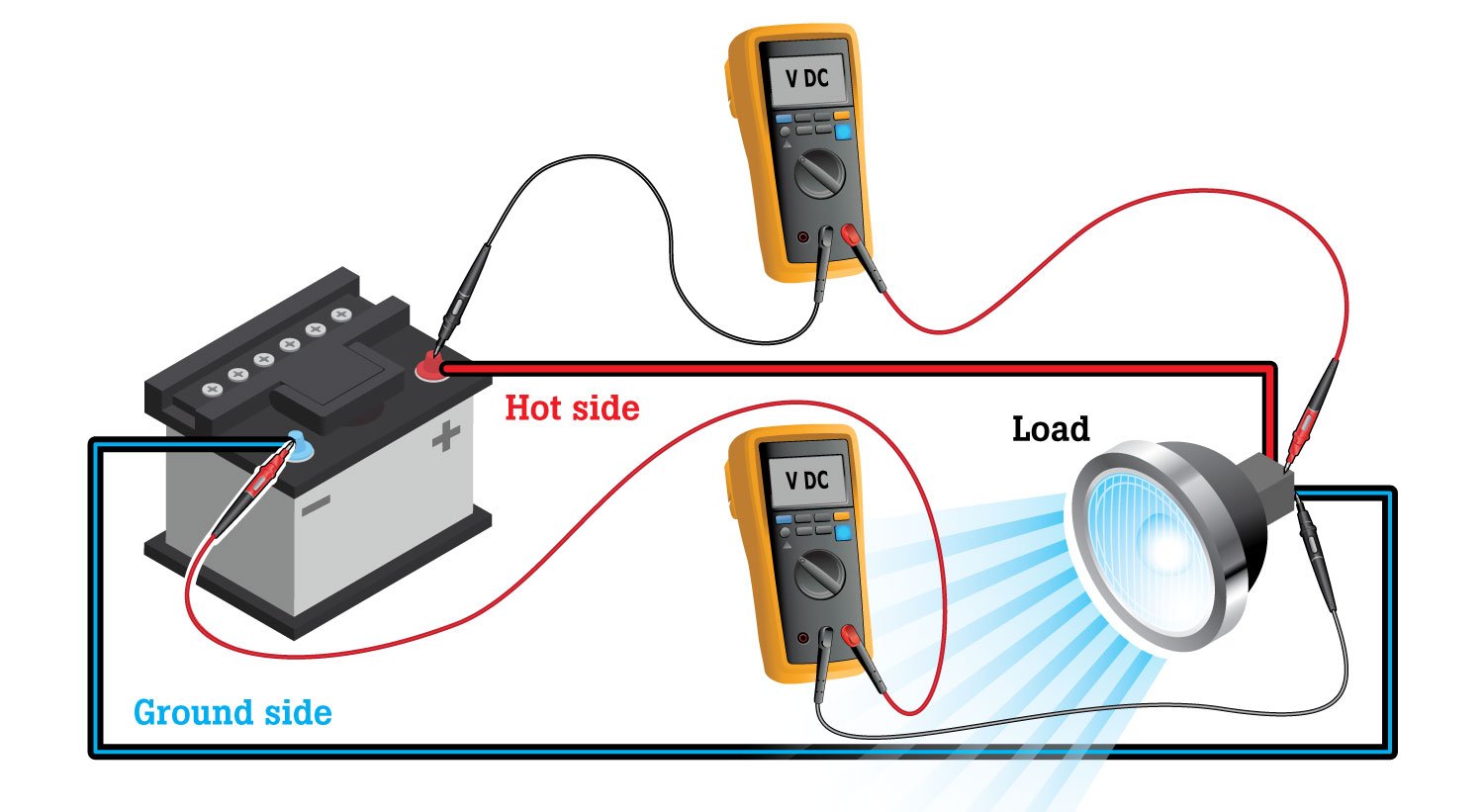How To Fix Voltage Drop In Car
One of the most rampant electric maladies showing up in automotive service bays today is the phenomenon known as voltage drop. Left unchecked, voltage drop causes countless unsolved electrical mysteries, peculiarly when it infects the ground side of a circuit. It can also play a trick on you into replacing parts that are not bad.
The more connections and wiring a vehicle has, the more vulnerable the electrical system is to voltage drop.
Practice safe electrical service when containing electrical voltage driblet. This means measuring voltage drib earlier reaching whatsoever conclusions. "Voltage dropping" a circuit tells you when the circuit is too restricted to operate a component (e.1000., motor, relay, light bulb) or operate it correctly. If the circuit is restricted, repair information technology and retest. If in that location is no brake and the component still does not run or run correctly, so supercede the component.

In this instance, when a wire falls off or a connection breaks, current stops flowing, and the voltage drops to nix. The starter motor would turn off or a headlight would become out.
Symptoms of voltage drop
Often confusing and contradictory, electrical voltage driblet symptoms vary according to the circuit's job and the severity of the voltage driblet.
- Inoperative electrical parts
- Sluggish, lazy electrical devices
- Erratic, intermittent devices
- Devices that work sluggishly or erratically during periods of high electrical loads
- Excessive radio interference or noises in the radio
- Damaged throttle or manual cables or linkage
- Repeated throttle or transmission cable failures
- Damaged drivetrain parts
- Engine or manual operation complaints
- No-starts or hard starts
- High sensor or computer voltages
- Erratic engine or transmission reckoner performance
- Simulated trouble codes in the memory of any on-board computer
- Premature or repeated A/C compressor clutch failure
This symptom list brings up several points.
- Visual inspections miss most cases of electric voltage driblet. Y'all usually can't see the corrosion inside a connectedness or the damaged wire that is causing the problem.
- Ground-side voltage driblet, a commonly overlooked cause of electrical problem, tin can cause most of these symptoms. Any circuit or component is but every bit good as its basis.
- The more than sophisticated electric systems become, the more important their grounds are. The number of electrical components has increased chop-chop and most exercise non take split ground wires. Instead, these devices are grounded to the engine or body. Rust, grease, vibration and/or careless repairs often restrict the excursion from the engine/body dorsum to the bombardment.
- Many components, such every bit engine sensors, share a common basis. Therefore, a bad ground complicates diagnosis because it affects several components at in one case.
- Some shop manuals and diagnostic charts or fault trees recommend checking grounds terminal. It is much quicker to check ground circuits before you climb that error tree.
- It is quicker and smarter to routinely cheque a excursion's voltage drop than it is to memorize long lists of symptoms. If feel has taught the states nothing else, information technology is that chasing symptoms is no substitute for routine and thorough voltage drib testing.
Experience has taught us other reasons to check voltage drib kickoff. Voltage drib, usually on the footing side, causes inaccurate or baroque digital multimeter readings and oscilloscope patterns. Moreover, when y'all connect a digital multimeter or scope to a arrangement with bad grounds, the test equipment itself can create a good substitute ground, depending on the instrument's impedance. If impedance is low enough, this can exist frustrating—if your equipment is connected, the circuit works, and y'all tin't find annihilation wrong.
Basic procedures
Whenever an electrical problem gives you fits, take a deep jiff and think of the basic electric building block: the series circuit. No affair how complicated a system is, yous can e'er simplify information technology to smaller serial of circuits. Then, inspect each excursion for voltage drop.

In an electrical excursion, electrical force per unit area (voltage or volts) pushes electrical volume (current or amps) through the circuit, operating a load. The load may be a reckoner, a motor, a lamp, a relay or other device. Electrical force per unit area (voltage) is used upward operating the load. Therefore, voltage falls to about nil on the ground side, simply current keeps flowing toward the battery. Because the voltage in a salubrious ground excursion should exist most zero, some technicians call it footing zilch.
Ground-side voltage drop hurts load performance and causes a voltage reading at the ground side of the load.
Resistance—Restriction
Excessive resistance on an electrical circuit can cause a brake in current flow. Bad connections and broken or undersized wires human activity similar a pipe with a kink, restricting current flow. Restricting electric current flow anywhere—hot side or basis side—hurts the operation of the load. The effect on the load is hard to predict because it varies with the severity of the brake. For example, the motor in a restricted circuit may stop working or only run slower than normal.
A restricted circuit can cause an a/c compressor clutch to slip and prematurely fire out. A figurer on a restricted circuit may close off or piece of work erratically. When corrosion, loose connections or other types of resistance restrict a circuit, volts and amps both drop. If volts drop, amps drib as well. That is why when you detect a voltage drop in a connection or cablevision, you know the connection or cable is restricted.

Expect at the circuits in our drawings and remember two critical points:
- A costless-flowing ground side is as important as a free-flowing hot side.
- A ground-side restriction is the but thing that causes voltage readings greater than 0 to 0.1V in any ground circuit.
A cleaved footing wire totally blocks current menstruation, shuts off the load and causes the ground side of the load to read arrangement voltage.
Voltage drop tests
Electrical voltage drop varies according to current flow. Unless you operate the excursion so current flows through information technology, you cannot measure out voltage drop. Because a digital multimeter's battery cannot supply the current that ordinarily flows through about circuits, digital multimeter tests usually cannot find restrictions as accurately as a voltage drop test.
Open-circuit problems such as broken or disconnected wires or connections finish current menstruation. After you prepare an open up excursion, switch the circuit on again and cheque for lingering voltage driblet. Until you lot go current flowing and check the circuit again, you cannot know if the entire circuit is good for you.
Although resistance-free connections, wires and cables would be ideal, most of them volition contain at to the lowest degree some voltage drop. If your manuals do not listing voltage drop values, use the following equally maximum limits:
- 0.00V beyond a connection
- 0.20V beyond a wire or cablevision
- 0.30V across a switch
- 0.10V at a ground
Because most computer circuits operate in the milliamp range, they exercise not tolerate voltage drop besides as other circuits do. Note that a milliamp is one-thousandth (0.001) amp. The recommended working limit is 0.10V-drop across low-current wires and switches. Testing low-electric current circuits as well requires a high-impedance (ten-megohm) digital multimeter. A low-impedance digital multimeter may load a low-electric current circuit so much that it gives an incorrect reading or no reading at all. Most professional-grade digital multimeters have x-megohm input impedance. Using a digital multimeter is the fastest way to accurately measure voltage driblet. If the digital multimeter yous ain does not have auto-ranging capability, use a low-voltage (0 to 1V) scale for voltage drop testing. Remember that test lights are not accurate enough to diagnose electrical voltage drib and tin impairment most computer circuits.
Quick ground tests
Because ground circuit voltage driblet tin cause most of the symptoms listed before, consider adopting this new work addiction: test grounds first. Before you do a tune-upward, bank check out electric problems, or test a starting, charging, ABS, or ac system, routinely test the engine and trunk grounds. Connect your digital multimeter betwixt the engine and negative battery terminal. Safely disarm the ignition and crank the engine for a few seconds, or if your multimeter has a information recording part it will capture the reading in as little as 100 milliseconds.
If the voltage drop is excessive, repair the engine ground circuit and retest. Notation that on some ignition systems without a distributor, the simplest way to prevent the engine from starting during the ground test is to pull the fuel pump fuse. Side by side, connect the digital multimeter betwixt the negative bombardment final and the vehicle'southward firewall. So get-go the engine and switch on the major electrical accessories. If there is too much voltage drop, then fix the body ground and retest.
Once the engine and body grounds are within limits, proceed with your diagnosis. Do non be surprised if fixing these grounds solves the car's problems. The fact that a vehicle passes the body ground examination does not mean you lot can safely basis your digital multimeter wherever y'all want to. Some technicians take run in circles for hours because their digital multimeters were not well grounded. For condom electrical service, make yourself a 20- or xxx-human foot jumper wire with an alligator clip on each end, allowing you to exam an electric fuel pump, lighting arrangement or ABS figurer in the rear of the vehicle by grounding your digital multimeter to the bombardment with the jumper wire.
Computer ground kinks
Considering computer circuits operate on such low current, the standard footing tests may non reveal a marginal ground on an on-board computer. Before you condemn any on-lath reckoner, check its grounds outset. Operate the computer system and back-probe each reckoner footing concluding. If you measure annihilation greater than 0.10V, trace that footing excursion and locate the problem.
Sometimes figurer grounds are connected to a spot where they are hands disturbed or prone to corrosion, such equally a thermostat-housing bolt. Calculator connector terminals tin can too corrode. Removing the connector and spraying the terminals with electrical cleaner may be all information technology takes to eliminate the voltage drop.
Feel shows that equally footling every bit 0.30V on a figurer ground concluding can cause trouble. Before pinpointing that with an electronic test light, remember that a traditional test light pulls likewise much current and can damage the figurer. Poor computer and/or sensor grounds can crusade higher-than-normal sensor voltages and fake problem codes. In many cases, the bad footing prevents the calculator or sensor from pulling a voltage point downwardly to or nigh footing goose egg. Accessing the figurer to check grounds may be a hassle, nonetheless, mistakenly replacing expensive sensors and computers is a bigger hassle.

Connect a digital multimeter across any part of a circuit to directly read the voltage drop across that wire, cablevision, switch or connexion. In this instance, one digital multimeter would display the voltage loss between the battery and the load, the other would show the voltage loss from the ground side of the load to the battery.
Trunk ground gremlins
Keep your optics peeled for missing body grounds. If someone else worked on the vehicle, they may have forgotten to reconnect body ground wires or cables. Recall that when the trunk ground is restricted electric current tries to discover another route back to the battery. The easiest alternate road may be through the transmission shift cablevision or the throttle cablevision. Not only tin this current weld the cable together, information technology also can pit or erode bushings and bearings inside the transmission or bicycle bearings.
If you lot detect the insulation on the body basis wire is burnt or blistered, you lot tin can bet that starter current overheated the wire. When the engine ground is restricted, starter electric current tries to render to the bombardment through the body ground circuit. Feel shows that if the body ground circuit can not handle the current load, the customer may non discover the trouble correct away.
Nether periods of heavy current period, a restricted body ground may hamper or shut off a component. For case, turn signals have been known to stop blinking when the commuter steps on the brake pedal. Testing confirmed that a restricted trunk ground choked off the turn signals. The basis could not handle the current from the turn signals and the brake lights at the same time.
Rubber service
Practicing prophylactic electrical service helps you solve electrical problems quicker and more profitably than guessing and swapping parts out. Put your digital multimeter to work, wiping out electric voltage drop, today. It is the responsible matter to do.
How To Fix Voltage Drop In Car,
Source: https://www.fluke.com/en-us/learn/blog/automotive/electrical-automotive-troubleshooting
Posted by: godwinaces1963.blogspot.com


0 Response to "How To Fix Voltage Drop In Car"
Post a Comment